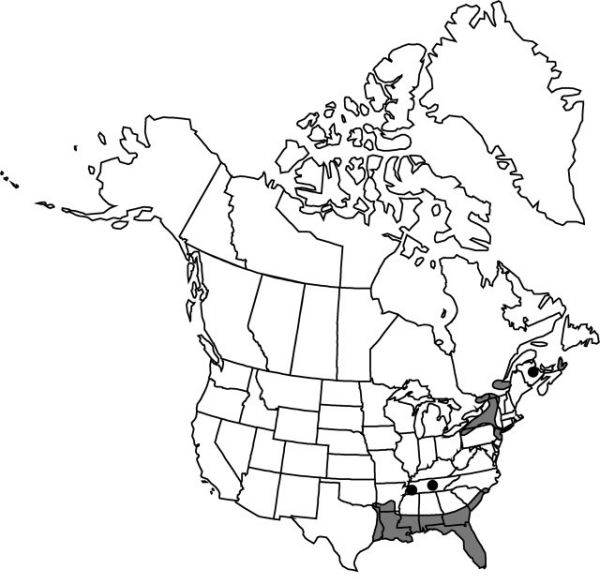Listera australis
Gen. Sp. Orchid. Pl., 456. 1840.
Plants 8–29 cm. Stems purplish green, succulent, glabrous. Leaves: blade dark green, ovate, ovate-oblong, or elliptic, 1.3–4 × 0.5–2.1 cm, base often subcordate, apex obtuse to apiculate. Inflorescences 5–25-flowered, lax, 45–110 mm; floral bracts suborbiculate-ovate, 2 × 1 mm, apex obtuse; peduncle and rachis slightly glandular-puberulent; bracts, pedicel, and ovary glabrous. Flowers reddish purple; pedicel filiform, 4–6 mm; dorsal sepal ovate-elliptic, concave, 1.5 × 1 mm, apex obtuse; lateral sepals ovate, falcate, 1.5 × 1 mm, apex obtuse; petals recurved, oblong, 1.5 × 0.5 mm, apex obtuse; lip linear, 6–12 × 1.5–2 mm, base extended into 2 rounded, linear lobes, projecting distally, partially surrounding column, distal half split into 2 linearlanceolate lobes with minute tooth in sinus; column 0.5–1 × 0.5–1 mm. Capsules horizontal, ovoid, 8 × 5 mm, with relatively few large seeds.
Phenology: Flowering Jan (Fla)–Jul.
Habitat: Rich humus of low moist woods, marshes, sphagnum bogs, usually in association with rhizomes of cinnamon fern (Osmunda cinnamomea) and royal fern (O. regalis)
Elevation: 0–1000 m
Distribution

N.B., N.S., Ont., Que., Ala., Ark., Fla., Ga., La., Miss., N.J., N.Y., N.C., Okla., Pa., S.C., Tenn., Tex., Vt.
Discussion
Perianth parts of Listera australis persist as capsules mature. This is such a small orchid that it can easily be overlooked; it may have a wider distribution than recorded here.
Selected References
None.